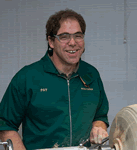Note – This post is from our newsletter archives. It was the President’s message by Pat McCart from the June, 2009 issue of Chips & Shavings.
 I know many of you will find this hard to believe, but at times I find myself at a loss for words. No, not things to talk about – I can always manage that. When Iʼm talking to someone, I talk and listen in turns. I only have to carry a part of the conversation, the person or people Iʼm talking with contribute as well. A conversation is not just dependent on me.
I know many of you will find this hard to believe, but at times I find myself at a loss for words. No, not things to talk about – I can always manage that. When Iʼm talking to someone, I talk and listen in turns. I only have to carry a part of the conversation, the person or people Iʼm talking with contribute as well. A conversation is not just dependent on me.
Writing, however, is different – itʼs just me and the blank page and unfortunately for me the blank page is a very good listener and a very bad talker. It contributes nothing to help me carry the narrative forward. So at times I struggle with “Writerʼs block”. Like today Iʼm stuck – I have no idea what Iʼm going to write for this monthʼs newsletter!
I donʼt have this problem when Iʼm turning wood. Even though wood turning is similar to writing in that itʼs just you and the blank piece of wood, I never get “Turnerʼs Block”. Wood has a language of its own to communicate with. A non-verbal one, but a language nonetheless. It contributes to the conversation I have with it as Iʼm turning it. Like speaking with another person, it helps carry the narrative forward.
Like all languages you have to learn the vocabulary to understand it. Wood communicates in many ways. The shape of the rough wood blank tells me what I can expect to make from it. The figure and coloring of the wood blank tells me what the finished piece may look like. If itʼs spalted it tells me its been on the ground and is in the initial stages of decay. If itʼs spalted and punky it tells me that the decaying process is well underway. That Iʼll need to use wood hardener if I am going to turn it and to go easy with the sandpaper as the softer punky wood will sand away quicker than the surrounding harder wood. If the lathe vibrates and moves it tells me Iʼm spinning it too fast and that I havenʼt trued and balanced the piece properly. If, when I stop my lathe to inspect my work, I find the surface ragged and rough it tells me that my tools are dull or that Iʼm not holding them correctly. Iʼm usually guilty of both. A smooth shiny surface tells me that my tools are sharp and Iʼm holding them correctly. These are just a few of the non-verbal ways wood communicates with us; there are many more and I still have a lot to learn, but then thatʼs part of the fun of wood turning.
I still donʼt know what Iʼm going to write for the newsletter this month. If only this blank sheet of paper would speak to me like a blank piece of wood does. Oh well, Iʼll think of something eventually, I suppose. In the meantime I think Iʼll go to the shop and work on my language skills. There is a special piece of wood Iʼve been saving and I think itʼs time we had a little talk.


Details on your classes = time, place, cost
want to add a lathe to my woodshop and looking possibly to a used one
Been looking at the general intl, 25=200 or the jet jwl=1442 vsk
How do I contact the turners group in fife?
Thank you
Chet
Hi Chet, we meet on the third Thursday of each month at the Fife Community Center. You can check out our location page. You can see a great demonstrator and get hooked up with one of our mentors.